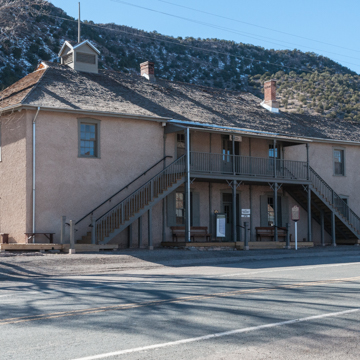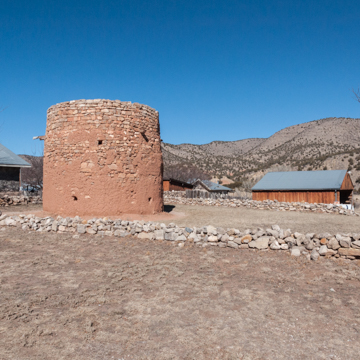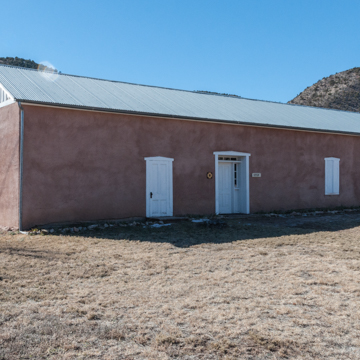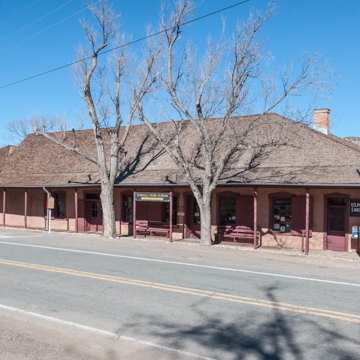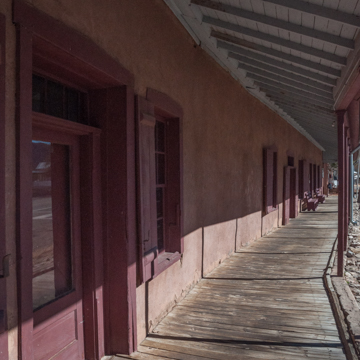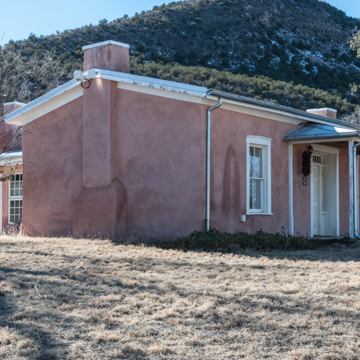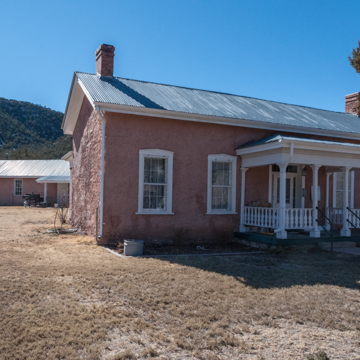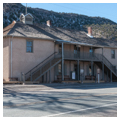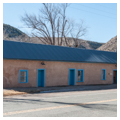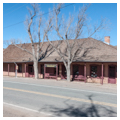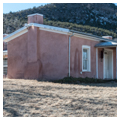Lincoln is a well-preserved example of the frontier cow towns built across the American West during the second half of the nineteenth century. Belying the clichés of 1950s Westerns, there are no rows of false-front buildings with connecting boardwalks. Instead, this modest settlement has one- and two-story commercial buildings and residences strung alongside a river between flanking mountain ridges, typically with pitched roofs and standing in detached lots to either side of a winding country road. The town is known best for the Lincoln County War and its association with Billy the Kid. As explained by the historian Robert Utley, the war that brought gunslingers together with the Mescalero Apache, the U.S. Army, Hispanics, and immigrant Americans, “dramatized economic forces that underlay most frontier conflicts… [and] demonstrated the intensity and the varieties of frontier crime.”
Lincoln is located at nearly 6,000 feet in the Rio Bonito Valley, with the Capitan Mountains to the north, the Sierra Blanca to the west, and the Sacramento Mountains to the south. Starting in the 1500s, Apache tribes began moving into what became home to the Mescalero Apache in the eighteenth and nineteenth centuries. Their presence kept Spanish and New Mexican settlers at bay until the U.S. Army arrived following the Mexican-American War of 1846–1848. Fort Stanton was established on the upper Rio Bonito in 1855 as part of a general campaign to suppress Indian resistance to westward expansion by the United States. In 1862, the New Mexico Volunteers under Colonel Christopher “Kit” Carson interned the Mescalero (along with the Navajo) at the Bosque Redondo Reservation. They returned to the area around Fort Stanton in 1865 and were settled permanently on their ancestral lands in the Sacramento Mountains when President Grant proclaimed the Mescalero Indian Reservation in 1873.
Hispanics began settling in the valley in the 1850s, setting up farms and small ranches that clustered around La Placita del Rio Bonito, a village eight miles from Fort Stanton. After the Civil War, they were followed by American merchants, professionals, and ranchers eager to exploit the opportunities offered by the government contracts to provide beef, corn, and hay to the Army post and Mescalero Reservation. The region’s growing economic importance was acknowledged in January 1869, when the Territorial Legislature established Lincoln County, a vast swath of mostly uncharted land covering 30,000 square miles; the following December, the legislature changed La Placita’s name to Lincoln.
La Placita del Rio Bonito drew its name from the plazuela de jacales at its center: a small plaza ( placita or plazuela) within a perimeter of jacal houses, rudimentary huts of vertical poles lashed together and plastered with mud. Inside stood a fortified stone tower, the Torréon. These first dwellings were followed by more substantial structures with adobe walls and viga roofs covered with hand-hewn planks and earth. The José Montaño Store and House (circa 1868) is representative, as is a building known as the Convento: built as a saloon and social hall in the 1860s, it also served as a circuit courthouse in 1869–1881, and then became a priest’s residence or convento in 1884–1903.
The gable roofs of corrugated tin, the window- and doorframes of sawn boards, and the window glass on these buildings were modifications introduced by New Mexico’s Americanization during the second half of the nineteenth century. Milled lumber was first brought to the territory by the U.S. Army during the Mexican-American War and became common by the 1870s. Often embellished with simplified classical details, it produced a regional variant of the Greek Revival called the Territorial Style. The Courthouse—built as the Murphy Store in 1874 and repurposed as the Lincoln County Courthouse from 1880 until 1913—and the Tunstall Store (1877) are characteristic of this period. Like the earlier Hispanic houses, these have adobe walls, but their porticos and porches, floors and pitched roofs were built with standardized lumber and machined nails.
Plate glass, corrugated tin, and commercially manufactured architectural elements became widely accessible and affordable after the railroad reached New Mexico in 1879–1880. Used to modernize earlier buildings like the Montaño Store, these industrial materials were incorporated as well into new structures of adobe and milled lumber like the Sheriff Brent House (1886), the Dr. Wood House (1886), the San Juan Church (1887), and the J.J. Dolan House (1888).
The events that made Lincoln famous were economic in origin. Fort Stanton existed to pacify the Mescalero and protect the settlers. But this military objective was entangled with financial interests when the settlers came to depend for their livelihood on government contracts to feed the fort and reservation. The resulting co-dependence between Fort Stanton, the Mescalero Reservation, and Lincoln justified the Army’s continued presence long after the fort’s initial and provisional purpose had been exhausted. Inherently instable and finally unsustainable, this bubble economy nonetheless offered lucrative opportunities to canny if unscrupulous businessmen.
In 1867, two former Army officers, the Irishman Lawrence G. Murphy and the German Emil Fritz, set themselves up as the post sutler to Fort Stanton; in 1871, they obtained a license from the Indian Agency to supply the Mescalero Reservation. Murphy and Company moved quickly to monopolize the agricultural economy of the Rio Bonito Valley. Because this economy was largely cashless, the company paid farmers and ranchers with credit at the store, creating a captive market while extending loans that further indebted them to the company. Suspected of engaging in corrupt practices that included falsifying vouchers, inflating the weight of beef, and over-counting the Mescalero, Murphy and Fritz were evicted from Fort Stanton in 1873.
By then, however, they controlled the valley’s economy and simply moved their company down the road to Lincoln, where they already had a branch store. In 1874, after Fritz returned to Germany and died, Murphy partnered with another Army veteran and Irishman, James J. Dolan, and built a new company store called “The House” at the west end of town. The main block housed the mercantile business on the ground floor and residential quarters on the upper floor, while the smaller east wing held a billiard room and saloon downstairs and a Masonic Lodge above.
Competition arrived first from the cattle baron John Chisum, who had extended his ranching empire from Texas to New Mexico in 1854 and who underbid Murphy and Company in September 1874 for a contract to supply beef to the Mescalero. Next came John Tunstall, an Englishmen looking to make his fortune in the American West. Tunstall reached Lincoln in late 1876 and in 1877 (with gold drafts from his father, a London merchant) set up a mercantile store that aimed to disrupt Murphy and Company’s monopoly by issuing “grain notes” to local farmers against their future crops, thus attaching them through debt to his rival business. Tunstall joined forces with Chisum and Alexander McSween, a Scotch-Canadian lawyer recently decamped from Kansas. Together, they set up shop in downtown Lincoln, on property purchased (ironically) from Murphy. Behind a continuous portico that curves along Lincoln’s single street, the building held Tunstall’s mercantile business in the middle, between a bank financed in part by Chisum at the east end and McSween’s law office beneath a separate roof at the west end.
Shrewdly, Murphy retired in March 1877, selling his share in the company to James Dolan. Dolan partnered in turn with another Irishman, John. H. Riley, but from the start Dolan and Company was in trouble as a combined result of loans taken out to buy the company from Murphy, the practice of extending credit to local farmers, and diminishing contracts with the Army and Mescalero Reservation. Even without Tunstall’s competition, Dolan and Company was headed toward bankruptcy. Though Dolan and Riley fought back with every means possible, including trading in beef rustled from Chisum’s herds, they were forced in January 1878 to mortgage their company to the Santa Fe lawyer and businessman, Thomas B. Catron.
In another place and time the story might have ended here. For Lincoln in 1878, however, the rivalry between two mercantile companies was the catalyst to a bloody outbreak of violence and lawlessness called the Lincoln County War. Key instruments in this war were two pieces of modern technology: the Colt .45 revolver, called “The Peacemaker,” and the Winchester Model 1873 rifle and carbine, known as “The Gun that Won the West.” Introduced in 1873, both were repeating weapons that used reliable metal cartridges. On one side of the war were Dolan and Company, allied with a gang of outlaws called “The Boys,” and backed by the sheriff of Lincoln County, William Brady. On the other side were Tunstall and McSween, allied with a group of cowboys who called themselves “The Regulators” after being deputized by Lincoln’s constable; they included a gunslinger known as Billy the Kid.
The war began when Tunstall was shot dead by Sheriff Brady’s posse in February 1878. It escalated when the Regulators ambushed and killed Brady in the center of Lincoln in April 1878, and culminated in the “Five Days Battle” of July 15-19, when McSween’s house was set on fire and McSween was murdered while trying to escape. The violence continued until April 1879, when the newly appointed Territorial Governor, General Lew Wallace, rode down to Lincoln from Santa Fe and promised to clean things up. Some 200 people on both sides were indicted, though everyone except for Billy the Kid escaped justice in the end.
Despite a promised pardon from the governor in exchange for his testimony, Billy the Kid was tried and convicted in Mesilla for Brady’s murder and returned to Lincoln to be hanged. In April 1881, he escaped from jail in the former Murphy-Dolan Store, now the Lincoln County Courthouse, only to be tracked down and killed by Sheriff Pat Garrett at Fort Sumner on July 13. The death of this hired gun in a larger economic fight symbolically concluded the Lincoln County War. The surviving principals who went on with their lives included James Dolan: he took over the Tunstall Store in 1882 and built his house across the street in 1888.
The Rio Bonito Valley returned to farming. Yet the shift from range-fed cattle to stockyards and the turn to new types of feed like alfalfa heralded its economic decline; in 1883, four Kansas contractors took advantage of the railroad and underbid local merchants to provide hay and grain to Fort Stanton. In 1889, portions of Lincoln County were split off to create Eddy and Chaves Counties, Fort Stanton finally closed in 1896, and the county seat was moved from Lincoln to Carrizozo in 1913. The courthouse became a high school until the school was transferred because of declining population to Capitan in 1931.
In 1937, the Lincoln County Society of Art, History, and Archeology deeded the former courthouse to the State of New Mexico and the town remade itself as the tourist destination it is now. The Torréon was rebuilt from its foundations in 1937, and the courthouse was restored in 1938–1939 to its form in 1881. Lincoln was named a New Mexico State Monument and Historic Site in 1937, designated a National Historic Landmark in 1960, and registered as a historic district on the National Register of Historic Places in 1966. The 1978 Lincoln County Historic Ordinance regulated the town’s architecture and form. Five historic buildings and a visitors’ center are open to the public during regularly scheduled hours.
References
Greenwood, Richard, “Lincoln Historic District,” Lincoln County, New Mexico. National Register of Historic Places Inventory–Nomination Form, 1975. National Park Service, U.S. Department of the Interior, Washington, D.C.
New Mexico State Planning Office. Lincoln, New Mexico: A Plan for Preservation and Growth. Santa Fe: State Planning Office, 1974.
Utley, Robert M. High Noon in Lincoln: Violence on the Western Frontier. Albuquerque: University of New Mexico Press, 1987.
Wilson, John P. Lincoln. New Mexico State Monument. Santa Fe: Museum of New Mexico Press, 1993.

